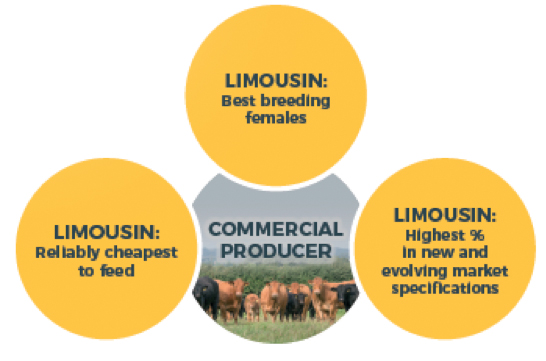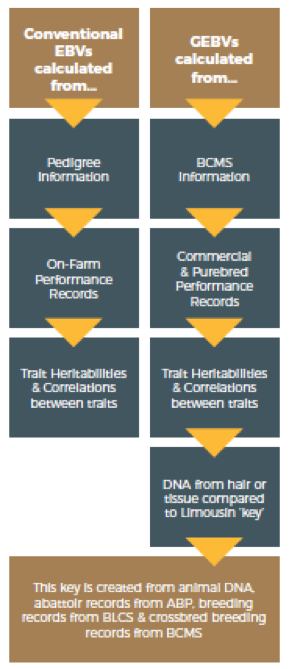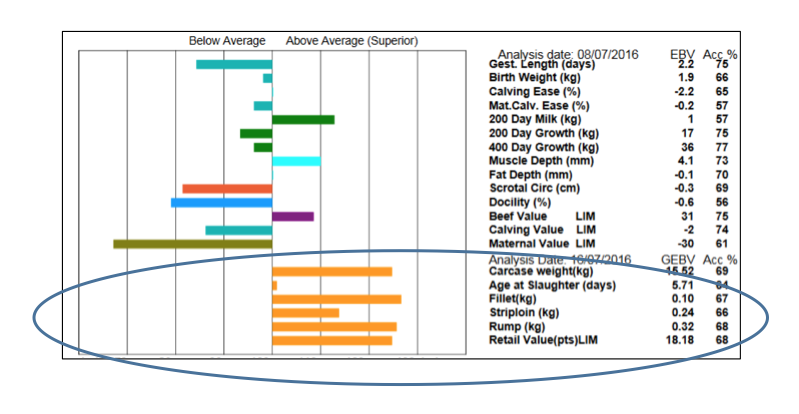The GEBVs available now represent an investment of £1.95 million and provide commercial producers with opportunity to:
- Reduce costs of production by increasing calf returns and reducing the replacement cost for breeding stock
- Dovetail the new GEBVs with the existing Carcase Trait GEBVs to identify breeding animals with the genetic potential to excel across several areas of production.
- Find new markets and generate new income streams through the sale of high performance genetics for these traits
- Increase the rate of genetic improvement in the herd for these traits
- Use GEBVs as an additional promotional tool when selling breeding stock
It is an exciting area of work; it is the first of its kind for beef cattle in the UK and represents delivery of the aims set out in the BLCS’ Breeding Improvement Plan adopted in 2014. The objective of this is to invest in targeted areas of the breed’s performance to ensure it delivers market-focussed genetics for today and the future. The new GEBVs present quantifiable financial opportunity to commercial producers of all Limousin-bred cattle.

“Feed efficiency, slaughter traits and maternal traits are the genomic prizes for beef production”. Professor Theo Meuwissen, co-founder of genomic techniques used in livestock, plant and human science today, speaking at the 2017 British Cattle Breeders Conference
GEBV stands for Genomic Estimated Breeding Value. It is an estimate of genetic merit produced from performance records, pedigree records (purebred and commercial) and information from animal DNA. It is different from a conventional EBV (Estimated Breeding Value) which does not use the information from the DNA. This can be illustrated as follows:

Introduced in 2017, these GEBVs are calculated from BCMS calving records of all Limousin-bred dams in the UK, pedigree information and DNA information from approximately 5000 animals.
GEBVs are produced for the following:
Age at 1st Calving (days) – select more negative values (ie less days) for animals more likely to hold to service at a younger age
Calving Interval (days) – select more negative values (ie less days) for animals more likely to have shorter times between first and second calves
Longevity (years) – select more positive values (ie more years) for animals more likely to last in the herd a long time
Calf Survival (%) 3 weeks to 10 month of age – select more positive values (ie for a higher %) of calves that are more likely to survive within this age range.
A calf inherits 50% of its genetic worth for these traits from its sire and 50% from its dam. Anyone using Limousin cattle – bulls and cows – to bred herd replacements should have an interest in sourcing the most suitable animals for the job. The breeding values for these traits are the only measures available that will enable a producer to assess the likelihood that a bull or cow can meet his/her requirements.
Age at First Calving and Calving Interval are recognised as key financial drivers in most types of breeding herd. The effects of high and low performance are well documented. Herd returns can be improved significantly where they are the focus of breeding policy.
The advantage gained from having these values as genomic breeding values are that the accuracy of the predictions is so much greater than could otherwise be achieved through using conventional EBVs. More robust breeding values mean better identification of the animals which have the genes to truly perform.
A ‘by-product’ of the GEBV evaluation is the production of EBVs for the same traits. These are based on pedigree and performance records alone, and do not use DNA information. Where animals have not been genotyped for the GEBVs, their EBVs will be displayed instead.
If animals have been genotyped for the GEBVs, the owners have the option whether to publish the values or not on an animal-by-animal basis. Published values will show on the Limousin database (www.basco.org) for each animal.
Where a member has chosen not to publish the values for a particular animal, a note will appear below its GEBV graph stating that ‘This animal has been genotyped for Maternal and Carcase Traits GEBVs’. Since an animal may only have one set of breeding values at any time – ie either conventional EBVs or GEBVs if it has been genotyped – the graph will appear empty where the GEBV values have not been published.
The Carcase Traits GEBVs are calculated from Visual Image Analysis (VIA) records from selected ABP abattoirs, pedigree information using the BCMS database and DNA information from approximately 5000 animals.
GEBVs are produced for the following:
Carcase Weight (kg) – adjusted to 600 days of age
Age to Slaughter (days) – adjusted to 350kg carcase weight
Fillet (kg) – adjusted to 350 kg carcase weight
Striploin (kg) – adjusted to 350 kg carcase weight
Rump (kg) – adjusted to 350 kg carcase weight
Silverside (kg) – adjusted to 350 kg carcase weight
Topside (kg) – adjusted to 350 kg carcase weight
Knuckle (kg) – adjusted to 350 kg carcase weight
Retail Value Index
Processors are increasingly using VIA measurements within their price grids. Having the tools to identify high genetic merit breeding stock for the traits that are driving the payment grid will enable producers to hit targets with their finished calves.
A ‘by-product’ of the GEBV evaluation is the production of Carcase Trait EBVs. These are based on pedigree and performance records alone, and do not use DNA information. Where accuracy exceeds 50% the values are published on the individual animal’s page on the basco database (www.basco.org). Pedigree breeders have access to the Carcase Trait EBVs for all their animals (irrespective of accuracy) to assist with decisions about which animals to genotype and gain higher-accuracy GEBVs.
• Work to date has identified a difference in retail value of around £100-150/carcase* between progeny from high GEBV sire and progeny from low GEBV sires. This is money for the taking when all it involves is selection of the correct sire. (* source: Meat Prices Index)
• Longer term, release of new breeding values for carcase traits will eventually be linked to a more sophisticated VIA payment grid taking into account the animals’ measurements.
• Improving female fertility in suckler cows has been shown to increase herd returns by up to £54/cow served per annum.
On a wider level, the advantages of GEBVs over EBVs also include:
• DNA, BCMS records and abattoir records all come from a mixture of independent sources and true commercial performance of Limousins: this significantly enhances the accuracy and volume of records generated by pedigree breeders
• Speed: GEBVs can be obtained shortly after a calf is born, thereby enhancing the accuracies of genetic merit predictions much quicker than performance recording alone.
• Improved accuracy: For many traits that have low heritabilities or are particularly difficult or expensive to measure, GEBVs will offer higher levels of accuracy than conventional EBVs.
• All owners of Limousin-bred cattle can gain GBVs: A significant difference between an EBV and a GEBV is that the former relies on the collection of performance records across groups of animals all managed in the same way. To gain the latter – a GEBV – all that is required is the DNA sample and the identity of the animal. It offers commercial producers significant opportunity in assessing current and future sires and replacement heifers.
The pathway that has been established will now open up many opportunities for the development of further GEBVs. The Female Fertility and Calf Survival GEBVs have been introduced in 2017. Work has commenced to investigate development of GEBVs for Feed Intake following the Society’s collaboration in Defra’s ongoing Beef Feed Efficiency Scheme.
Information on GEBVs is available at www.genesure.co.uk or by contacting Alison Glasgow, BLCS on 02476 696500 or email alison@limousin.co.uk
USING GEBVs
GEBVs are the most accurate predictors of an animal’s performance for traits that are often difficult or impossible to assess by any other means. This in turn enables producers to select the best animals for producing calves to suit their system and hit their enterprise targets. GEBVs use vast pools of performance information and DNA to build a picture of an animal’s capability and are without doubt the most reliable and consistent method of assessment.
When deciding which traits are of value, it is important to consider:
- Your farm type and system
- Your cow type
- The traits that make money (or lose money)
- The strengths and weaknesses of current stock in hitting your desired targets
GEBVs are used in exactly the same way as our conventional EBVs. An animal’s values are relative to all others in the breed and can either be visually assessed using a bar chart (typical at breed sales and in sale catalogues) or benchmarked against the current breed percentiles…
Bar Chart with GEBVs

The centre vertical line represents breed average for all traits. Bars that lie to the right of the line indicate the trait is above breed average, and the further they are to the right, the higher above breed average the traits are. Equally, bars that lie to the left of the centre line indicate the trait is below breed average.

Example:
A bull with values as follows… Ranks in the breed as follows…
| Carcase Weight (kg) | 4.80 | Average | |
| Slaughter Age (days) | 1.75 | Top 25% | |
| Fillet (kg) | 0.16 | Top 25% | |
| Striploin (kg) | 0.45 | Top 25% | |
| Topside (kg) | 0.80 | Average | |
| Rump (kg) | 0.61 | Top 10% | |
| Silverside (kg) | 1.1 | Top 25% | |
| Knuckle (kg) | 0.33 | Bottom 25% | |
| Retail Value | LM25R | Average |
The Retail Value is a single figure economically-weighted index comprising the six carcase cut GEBVs; Fillet, Striploin, Rump, Silverside, Topside and Knuckle. The traits are economically weighted within it so their relative value is accounted for. Animals with high GEBVs for the carcase cuts will have a high Retail Value.
There is no single answer to this. Depending on your herd’s current level of performance and your ambitions, some traits will be more relevant to you than others. When considering this, it is important to take account of…
• The traits that make money (or lose money)
• Your farm type and system
• The end market you are aiming for
• Your cow type
• The strengths and weaknesses of current stock in hitting your desired targets
With caps on slaughter weight now a normal measure across many abattoirs, many herds find they can hit weight targets satisfactorily with Limousin cattle. How much more growth is required is probably a function of individual farm circumstance, any concerns surrounding cow size (where female replacements are retained) and the speed at which calves can be finished. There is very clear evidence that early slaughtering typically leaves a greater margin than late, and many enterprises have not yet captured the best genetics for this purpose.
VIA fat depth measurements are currently not collected so a GEBV cannot be produced. As the technology develops, this may become possible.
The advantage of GEBVs over EBVs is they can be obtained for traits that are difficult to measure using conventional EBV techniques and they can be obtained earlier in a calf’s life. Both are breeding values, however, that do the same job once they have achieved the same level of accuracy, so they should not be differentiated in this context.
Animals need to be genotyped in order to gain a GEBV. A hair or semen sample is submitted to the BLCS office. This is genotyped by a DNA laboratory and the genotypes returned to SRUC for inclusion within the GEBV analysis. A GEBV update is carried out three times a year and results are reported back to breeders through the performance recording database. Owners of animals with GEBVs can then decide those they wish to publish for public viewing.
For further information on genotyping, click here
PEDIGREE HERDS
Any animal can be genotyped at any point in its life, from newborn calf to senior bulls and cows. In deciding the order of priority, the following is a suggested approach…
1. Young heifers for retention in the herd – since GEBVs may help decisions about their retention and they are going to have a high level of impact in the years to come.
2. Stock sires
3. Cows in flushing programmes – again, their impact on the herd can be considerable.
4. Young bulls/heifers for sale – for marketing purposes
5. Older breeding cows
Yes. The conventional EBVs are as important as they have ever been and will continue to rely on farm records. Development of new breeding values in the future will also rely on current performance data.
Yes. Whilst there is evidence that the conventional Muscle Depth EBV is a very different trait to the new carcase trait GEBVs (see “Why Do Some Animals With High EBVs for Traditional Traits Have Low GEBVs for the New Carcase Traits?” below) decisions about whether to continue publishing cannot yet be made. If high accuracy EBVs are important to you whilst it still forms part of the performance recorded traits, then you should continue to scan.
TECHNICAL
The reference population is the early population of animals with performance records that were also genotyped. They largely form the ‘information library’ that is the basis of the new GEBVs and it is important this is sufficiently large and representative of the population if the breeding values are to be meaningful.
The recommended minimum size of a reference population is 4000 animals. The population for both the Carcase Trait and Female Fertility trait GEBVs was just under 5000 genotyped animals, so exceeded this. Additionally, animals were targeted to ensure DNA and performance measures were gained from across the breadth of the Limousin population. This is being enhanced all the time, as new animals are genotyped by breeders and through new research initiatives.
No. Dam breed type is gained from BCMS records and is accounted for in the evaluation.
The traits adjusted to 600 days of age are: Carcase weight, Fillet, Striploin, Silverside, Rump, Topside and Knuckle. This is important in identifying the speed at which carcase weight or the prime cut weights are achieved.
The traits adjusted for carcase weight are: Age to Slaughter, Fillet, Striploin, Silverside, Rump, Topside and Knuckle. Identifying the animals who can achieve a standard carcase weight (in this case 350kg) as quickly as possible is important. Adjusting the individual carcase cuts for carcase weight also identifies animals whose prime cuts form a greater proportion of their body weight rather than simply identifying those with large muscles.
The advent of this new technology is informing us more about the genetics of our cattle than we have ever known before. As with all breeding values, there are occasions when they predict what we think we already know about animals and there are occasions when they predict something quite different. The difficulty is what we do with that information; if it is too great a challenge to our thinking, we are unlikely to change from current levels of performance. If it is acknowledged and used in measured steps of development, change will inevitably be brought about.
The reasons why the conventional Muscle Depth EBVs and new Carcase Trait GEBVs don’t always indicate the same thing for the same animal is typically for one of two reasons:
i. The correlation between the conventional muscle depth and growth EBVs with the Carcase Trait GEBVs has been found not to be particularly strong.
The phenomenon is in keeping with findings elsewhere in the world. Whilst counter-intuitive, what this means is that muscle/growth at 400 days are just different traits to carcase characteristics at slaughter since slaughter typically occurs many months after 400 days. Whilst many animals have the genetics to grow well to 400 days and then go on and finish well, not all do.
ii. The second contributory factor is that the conventional muscle depth EBV is not adjusted for body weight. In other words, high growth rates can encourage high muscle depth EBVs, simply because the total mass of muscle is greater. Because the Carcase Trait GEBVs are adjusted for carcase weight, on the other hand, they indicate animals with higher/lower proportions of muscle in the carcase – and this is very different…
• In order to get high Muscle Depth EBVs, animals just need to have large muscles and many do that simply by being big.
• In order to get high Carcase Trait GEBVs, animals need to have high proportions of muscle relative to their body weight.
As a result of both these issues, it is entirely possible to have good breeding values for one and not the other. On a herd level it is frustrating & disappointing if animals fall in to this category. On a breed level, it is our ability to identify this and differentiate animals on this basis that will help ensure their place in the industry in the years to come and set the breed apart from others.
GEBVs use information from the animal’s DNA in their calculation as well as large volumes of performance records than can ever be achieved within the pedigree population alone. EBVs typically rely on significantly smaller amounts of records from within the pedigree population only
The early research phase of the introduction of VIA machines relied on repeated comparison of VIA records to actual boned-out measurements. The correlation between the two was 96% which is considered to be very high.
The machines are calibrated each day prior to use.
Information on GEBVs is available at www.genesure.co.uk or by contacting Alison Glasgow, BLCS on 02476 696500 or email alison@limousin.co.uk












